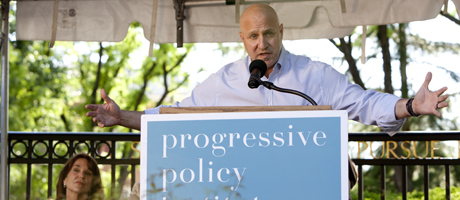By Jennifer Price
Across the U.S., 49 million Americans can’t afford enough to eat. About 15 million are out of work, and about 63 percent are overweight or obese.
Joel Berg, executive director of the New York City Coalition Against Hunger, has a plan to fix all three problems.
Mr. Berg wants the Obama administration to create a “Good Food, Good Jobs” initiative that would generate new jobs at places like grocery stores and farmers markets in low-income areas, while making nutritious foods available and affordable to the poor.
“Our hunger, malnutrition, obesity and poverty problems are closely linked. Low-income areas across America that lack access to nutritious foods at affordable prices tend to be the same communities and neighborhoods that, even in better economic times, lack sufficient living-wage employment,” Mr. Berg said while promoting his report, “Good Food, Good Jobs: Turning Food Deserts Into Job Oases,” during an event at the Foggy Bottom FreshFarm Market Wednesday evening. “The federal initiative would bolster employment, foster economic growth, fight hunger, cut obesity, improve nutrition and reduce spending on diet-related health problems.”
Tom Colicchio, head judge of Bravo’s Top Chef, said the face of hunger is very different than it was 30 years ago.
“When you think of someone that is hungry, you think of children in a third-world country, but hunger now looks like the elderly who have to make decisions between medication and food,” he said. “It looks like the recently unemployed who have to make decisions between keeping a roof over their heads and feeding themselves. And it looks like the working poor that during the course of a month will go hungry.”
According to Mr. Berg’s report, the higher the concentration of poverty within a neighborhood, the fewer supermarkets there are. Corner stores, bodegas and convenience stores, where it is difficult to find fresh and healthy food, fill in the gaps. Instead, processed foods, which are packed with sugar and empty calories, line the shelves.
And even if people are able to find nutritious food in those small convenience stores, the prices are generally higher than in larger supermarkets. That’s why Mr. Berg, who served as the coordinator of community food security at the U.S. Department of Agriculture in the Clinton administration, calls these low-income areas “food deserts.”
“In order for a community to have good nutrition, three conditions are necessary: food must be affordable, food must be available, and individuals and families must have enough education to know how to eat better,” said Mr. Berg, who prepared the report for the Progressive Policy Institute, an independent research institution founded in 1989 that advocates for radical policy solutions.
Mr. Berg wants to see the federal government giving grants and loans to create and expand existing community food projects including city and rooftop gardens, farmers markets, soup kitchens and urban supermarkets.
“Just as the Obama administration and Congress have supported a ‘green jobs’ initiative to simultaneously fight unemployment and protect the environment, they should launch the ‘Good Food, Good Jobs’ initiative to fight unemployment, obesity and hunger,” he said.
The government should also consider expanding urban fish farming and urban food processing, Mr. Berg said.
“Doing all this is really a win-win. In the best case scenario, it could create large numbers of living-wage jobs in self-sustaining businesses even as it addresses our food, health and nutrition problems,” said Mr. Berg. “But even in a worst-case scenario, the plan would create short-term subsidized jobs that would provide an economic stimulus, and at least give low-income consumers the choice to obtain more nutritious food—a choice so often denied to them.”
Ann Yonkers, co-director of FreshFarm Markets, which manages six markets in the District, four in Maryland and one in Virginia, said the markets are demonstrating that there’s a different way to eat.
“They are showing people that there’s a different way to raise animals. So if it’s a herbivore, it grazes on grass. It doesn’t stand in a stall and eat grain. There’s a natural way to grow vegetables so you don’t have pesticides, you don’t have herbicides, you don’t have fungicides,” she said.
FreshFarm Markets opened in 1997 with one market in Dupont Circle and 15 farmers selling fruit, vegetables, flowers and plants. Today, there are 11 markets and 125 farmers. In addition to fruit, vegetables, flowers and plants, they sell meat, cheese, bread and pastries. Last year, 300,000 people went through the 11 markets.
Mr. Colicchio, who just this week was named the 2010 James Beard Outstanding Chef, encouraged people to buy as much locally grown food as possible not just because it tastes better but because it actually is better.
“Fifty years ago most people cooked with foods that were grown within 100 miles of their home. Now a lot of what we buy is commercially processed somewhere far away. Not only do we not know who the farmer is, we may not even know what the ingredients are that we’re consuming. So if you are what you eat, we’re going to turn into a bunch of chemicals,” he said. “You need to be putting things in your body that are actually better for you. So go out and support your local farmers.”


